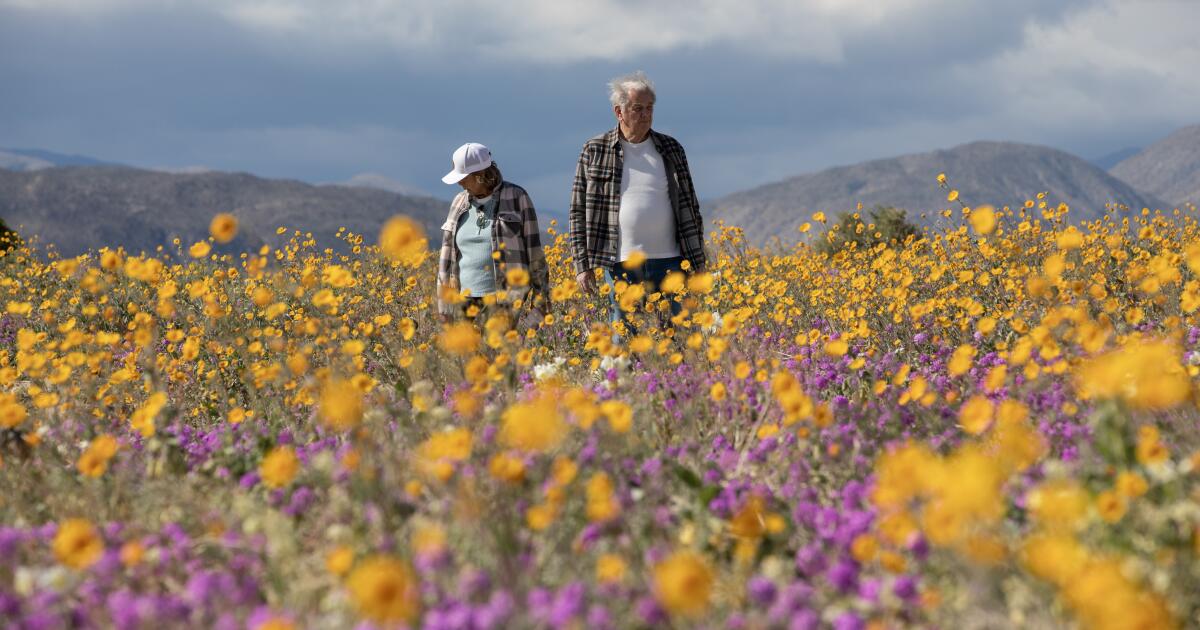
Wildflower season is underway in the Anza-Borrego Desert State Park, with flowers such as desert sand verbena, desert lilies and desert dandelions bringing a colorful glow to San Diego County’s backcountry this week.
It’s enough of a show that local experts are hopeful that this year could result in a “really good” bloom, said Jim Dice, reserve manager of UC Irvine’s Anza-Borrego Desert Research Center. But the flowers’ success is dependent on various factors, including additional spring rains, temperature changes and hungry insects.
San Diegans hoping to catch the flowers before their cycle is over should plan a trip to the desert soon. In certain areas of the park like Henderson Canyon, they can already see this season’s initial vibrant display.
“We don’t want to get anyone’s hopes up for it to be this crazy thing until we’re able to see it… but Henderson Canyon is a super bloom,” said Jaime Purinton, the communications manager for the Anza-Borrego Foundation. “I mean, it is a carpet of flowers.
“If anything blooms like Henderson Canyon, it’ll be insane,” she added.
The blooms are not dispersed evenly across the park, but are instead concentrated in certain areas, such as in Henderson Canyon and along Henderson Canyon Road. The canyon, located in a floodplain, is like a bowl, Purinton explained, so it easily collects water when it rains, helping the wildflowers that grow there. Visitors can currently spot desert sand verbena, white dune evening primrose and yellow desert sunflower on the road leading to the canyon.
Blooms are also sprouting near June Wash, Purinton said, and the hills of the state park are bright green, which could result in eventual blooms as well.
Rainfall levels are one of the main drivers in determining how well wildflowers will do each season.
The state park has seen 6.26 inches of rain since last July, according to UC Irvine’s Anza-Borrego Desert Research Center. The average amount of rainfall in the desert for the year is typically around 6 inches.
A large contribution came from heavy rains last August during Tropical Storm Hilary, which dropped 2.23 inches on the desert and resulted in a September bloom of flowers, Dice said.
Additional rains in the coming weeks would be beneficial for the wildflower blooms, but Dice said the desert region is expected to see a “warming trend” over the next 10 days, which would cause even more wildflowers to “pop” — or bloom quickly and have a shorter cycle.
“I would say it’s highly possible that the peak could be this weekend and through next week to next weekend,” Dice said. “By the middle of March, we could be on the downside.”

Gordon Kato, 66, of Oxnard, takes a selfie among the wildflower on Thursday, March 7, 2024 in Anza-Borrego Desert State Park, California. Kato drove four to five hours for the flowers. “It was worth it,” Kato said.
(Ana Ramirez/The San Diego Union-Tribune)
Along with changes in temperature, Dice points to the sphinx moth caterpillar, which is notorious for eating wildflowers and other desert plant life. Though he hasn’t yet heard reports of the insect this season, their presence could shorten the flowers’ time in the desert.
But if conditions are favorable — which would include low winds and mild temperatures — the flowers may remain through March and potentially into April, Purinton said.
Despite uncertainty over how long the blooms will last, Borrego Springs has prepared for large crowds of people vying for a chance to see the flowers, many of which have already started to arrive.
The number of visitors has tripled in the last two weeks, according to Françoise Rhodes, executive director of the Borrego Springs Chamber of Commerce. The town is offering free maps for visitors and has also set up additional restrooms and staffing where needed.
The Anza-Borrego Foundation, the Borrego Springs Village Association, business owners and park officials have also held meetings to prepare for the season.

A desert lilly on Thursday, March 7, 2024 in Anza-Borrego Desert State Park, California.
(Ana Ramirez/The San Diego Union-Tribune)
In some cases, planning for the wildflowers began over the winter. The Anza-Borrego Desert Natural History Association, along with the state park, prepared the land by pulling Sahara mustard, an invasive plant species, from the area. The species, if gone unchecked, can outcompete wildflowers for water resources, soil space and sun, according to Betsy Knaak, the association’s executive director.
Knaak hopes to give the wildflowers the best shot at survival, but invasive species aren’t the only threat to the blooms.
In 2017, during an especially large bloom season, there were traffic jams, restaurants ran out of food and people used the desert as their bathroom due to a lack of available public restrooms.
Two years later, when Borrego Springs experienced another successful bloom in 2019, the community set up traffic control measures and portable toilets to avoid a repeat of 2017.
Visitors are encouraged to respect the local community and the wildflowers by staying on designated trails, not stepping on vegetation or picking flowers and carrying out their trash. Also note that drone use is prohibited in the park.
Visitors can also access resources before they head out, including the Anza-Borrego Foundation’s interactive flower map, which allows visitors to upload photos of flowers where they see them.
“It shows in almost real time where the flowers are,” Purinton said. “So it’s kind of like this citizen scientist type project.”
The experts also note that wildflowers aren’t the only plants blooming in the desert right now; the iconic octotillo, cacti and smaller shrubs are also having a good year and can be admired in more remote areas of the park, if visitors are willing to hike.
Regardless of how people choose to see the desert’s spring flora, word about this year’s bloom is getting out.
Knaak, from the Anza-Borrego Desert Natural History Association, said she’s been fielding calls from out-of-town visitors who are hoping to see the flowers.
“I had a call from a man in Oregon who’s planning his trip here,” she said. “He asked me when is the best time [to visit] and I said, ‘Well, as soon as you can get here.’”





